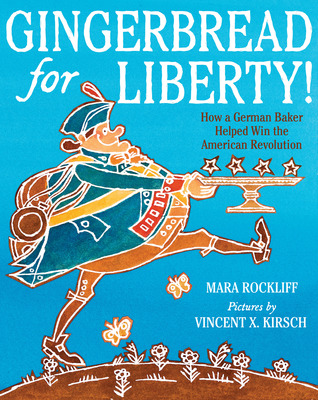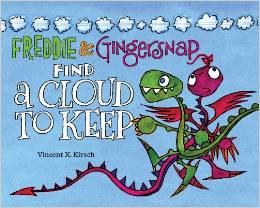VINCENT X. KIRSCH is an author and illustrator living in Los Angeles. He spent over thirty years in New York City before heading for the sunny side of the country. Before he happened into picture books, Vincent kept busy doing things such as working as a stockboy at the original Dean & Deluca (he later became the visual merchandiser, overseeing everything visual for all stores around the world), serving as the print art director at Showtime, designing Broadway posters, designing windows and displays for Bergdorf Goodman, and illustrating book jackets, to name a few. Then… one day, out of the blue, an editor called from BloomsburyUSA Children’s Books and asked if he was interested in doing picture books. His answer was “Yes! Very interested!!”
What inspired you to take your art into publishing?
Since I was a little kid, I always wanted to tell stories and create books. So it made sense that I would venture into picture books. It was after my years of working at Bergdorf Goodman that I started to make up characters that inspired stories that I turned into little books that I would drop-off at publishing houses. For one reason or another, no one but me could see my work translate into books. Everyone thought that my work looked “too European” or “sophisticated” for the US market. I tried several times to give up, but something urged me to keep at it.
You write and illustrate your own books. When you have an idea in mind, do you picture the words of the story first, or the art?
This is a tricky question for me. Here is why: I always start with a sketch of a character. Almost immediately, a name for the sketch comes to mind… then a story. So I usually write my stories with just the simple image of a character. The world and plot come about when I sit down and seek out the character’s story.
Can you detail your typical day as a working illustrator?
There is no such thing as a typical day, but I can describe my ideal day. I wake up on the early side, take a 40 minute swim, pull myself together, eat a little something, drink a great deal of iced coffee, answer emails, tweet, google this and that, etc, than I slightly organize my studio {moving my heaps and piles from one place to another, clearing my desk} which has usually gotten cluttered from the day before. All day, I move from worktable to writing desk to drawing board, from laptop to big desktop Mac. If I have errands to do I hop in my little black beetle {named Otto}and drive there, then back to work. I break for dinner and some evening diversion. Then, I am back at my desk or drawing board until quite late at night. I am truly a night owl and relish the hours of working into the night.
Do you have a favorite character from those you’ve created?
I have quite a few characters to choose from. Some say: “Too many!” but being what it is, I find it hard to have favorites. Each character has endeared itself to me for different reasons. In fact, I believe that the reason I have so many characters is that as a kid, I never wanted to leave any toy and friend out. An example of this is when I was a child and at the end of a busy day of opening Christmas presents, everyone else would grab a “new favorite” toy to take to bed with them. I would look at all of the toys left behind and grab as many of them as possible to take to my room with me, so that they would not feel left out. To me, toys had lives. To my little imagination, they came to life long before they belonged to someone. I often say that I collected spirits of things longing to be wanted. In time, they turned into the characters that I would create as a grown-up!
That said, I must confess that one of my first characters Marvellino, the pigeon king, is one that I love dearly.
What have you learned as a children’s book illustrator throughout the years?
To be very patient. Things take a great deal of time in publishing. One must persevere despite the abundance of kind rejections notes and comments that you get from editors. Keep a sketchbook. I like to date my ideas and projects, it helps me keep track of when ideas and characters were born. Play with all kinds of art materials. Experiment. Build a community for support and ideas. Artists are very lucky. Being able to make art is a great blessing. Do not give up!
What picture books or picture book characters resonated the most with you as a child?
For some reason, I related most to Bartholomew Cubbins and his 500 hats, as well as, his Oobleck problem. I had a strong attraction to Piglet. I wanted to live in the world that Hardie Gramatky depicted in Little Toot. Everyone used to tell me that I was just like Pinocchio [I was a very mischievous kid and told stories]. I felt more like Peter Pan [and I still do].
What is the one thing you wish you had known before being published that you know now?
Oh there is so much that I have learned since my first book. Looking back I wish that I had studied the art of storytelling so much more than I had. I have learned that stories must have arcs and conflict. I have recently learned of the powers of three. I have learned about the importance of “hooks” and “elevator pitches”. Most importantly, I have learned that simplicity is a very complicated thing. I am humbled by the responsibility of creating a book. I would do so many things differently. Also, don’t give up the day job!
What do you consider your greatest success as an illustrator?
How I think three dimensionally. I have left behind the two-dimensional world after working in display for so many years. I am a sculptor. I have a genius for spatial thinking. I think that my best work is work that shows that there is a whole world beyond and behind the images. I am very proud of the world that I rendered in my first book Natalie & Naughtily. I love that I have created a place to wander into.
How has having an agent and having your work published changed the way you work?
Having an agent is very much like the relationship between Pinocchio and Jiminy Cricket in the Disney film [not the books, where the poor talking cricket is crushed by a flying mallet]. A good agent, like the one that I have, is there to encourage me to keep at my work and not get overwhelmed with doubt. My agent knows a lot that I do not. She has some very clever tricks in her pocket. It amazes me most of the time. She is brave and is ready to have those conversations that are beyond me. She offers me feedback on my projects and helps me sort out ideas that work best. She is objective. She is a great sounding board and has excellent taste. Agents tend to be very busy, therefore it is best not to forget to drop them notes from time to time to tell them what is new. It has changed my work in that I do not feel that I am creating in a vacuum, all by myself. I have a partner in crime!

In your latest project with Houghton Mifflin Harcourt, Gingerbread for Liberty, you use gingerbread-style cutouts. How do you get inspired for illustration-only projects?
As an illustrator, the words are my greatest inspiration. My background as an editorial illustrator for newspapers and magazines prepared me for this work. For example, I would be in my studio and get a call from The New York Times or Washington Post: “Could I do an illustration?” If so, they would send {via fax} an article and I would have two or three hours to come up with a sketch than another few hours to complete the art. My job was to put the article into an image that would express what was said in the article and cause the viewer to read the article. In books, when I get a manuscript, I read it over and over until an idea to do the same things: put the story into pictures and cause the viewer to read the text. It is a sort of game. With the gingerbread book, I remembered how much fun I had designing gingerbread cookies and cutting my own shapes out to decorate. That book was a delicious project!

The second book in the Freddie & Gingersnap series comes out next year and the main characters are inspired by Fred Astaire and GingerRogers. How did this story come to be?
This one actually started with a creature that I invented long ago, called “an eitheraur”. In my imagining, it was a character that no one knew if it was a dragon or a dinosaur. I did a little sketch of the creature and filed it away. Then, years later, I had the idea for a book that I wanted to dedicate to Fred Astaire and Ginger Rogers. For some mysterious reason, I thought of turning my eitheraur into two characters: a dinosaur and a dragon. When I was very little, I thought that they existed at the same time. What if they met? I took a typical plot device from Fred and Ginger movies: two characters that would never dance together under normal circumstances, come together and take flight and even fall in love! Actually, creating that book was so much fun, seeing how the simple idea moved and changed. It is very much like creative collaborations. It really does take two to tango, be it an agent or editor.
Vincent’s books are available through Amazon, Barnes & Noble, and IndieBound. For more info about Vincent’s work, visit his website www.vincentxkirsch.com. Also follow him on Twitter @VincenzoXKirsch for updates!
Thanks for reading our first Author Chat, and be sure to check back next week for our next post!




